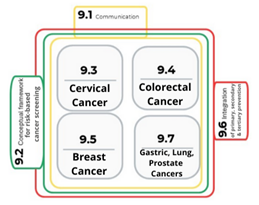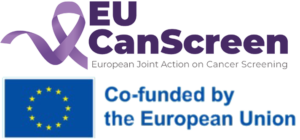April 2025
Project Updates
Cancer screening risk-based approaches WP9

Work Package 9 focuses on advancing the understanding and application of risk-stratified screening, an approach that tailors screening protocols to individuals based on their specific risk factors. Unlike standard screening programmes that apply uniform criteria to an entire population, risk-stratified screening considers genetic predisposition, family history, biomarkers, or behaviours as determinants of an individual’s risk. By adjusting screening intensity—such as the starting age, frequency, or type of screening test used—this approach seeks to optimise the balance between benefits and potential harms, making screening programmes more efficient and targeted. The overarching goal of WP9 is to support Member States in assessing and integrating risk-based screening strategies into their national programmes.
Structure and Tasks
WP9 consists of seven interconnected tasks aimed at developing risk-stratified screening frameworks, assessing implementation strategies, and providing evidence-based recommendations for national screening programmes.
WP9.1 focuses on informed decision-making and effective risk communication, evaluating methods and tools to support personalized screening programmes. WP9.2 establishes a common conceptual framework, defining risk assessment models and addressing ethical and implementation challenges. WP9.3 optimises cervical cancer screening by integrating vaccination status and previous screening history, while WP9.4 assesses risk-based colorectal cancer screening, analysing feasibility, effectiveness, and cost-efficiency. WP9.5 evaluates individualised breast cancer screening approaches, considering clinical, economic, and psychological impacts. WP9.6 promotes an integrated approach to cancer prevention by linking primary, secondary, and tertiary prevention strategies to strengthen risk –based screening. Finally, WP9.7 explores risk stratification in emerging screening areas, including lung, prostate, and gastric cancer, identifying key knowledge gaps and cost-effectiveness considerations.
Expected outcomes
WP9 is expected to deliver a comprehensive framework for implementing risk-stratified screening across European healthcare systems. By evaluating existing models, assessing feasibility, and addressing ethical, economic, and organisational challenges, this work package will provide Member States with practical tools for implementing risk stratified screening.
Work in progress
The WP9 partners have begun coordinating efforts and reviewing existing materials to establish a solid foundation for risk-stratified screening. Initial activities include mapping available evidence, assessing current risk assessment models, and analysing communication strategies used in ongoing pilot programmes.
WP 9.1 drafted the survey to collect information materials on risk-based screening and defined the search strategy for the literature review on informed decision making and decision aids for people invited to participate in risk- based screening.
Task 9.2 presented the basis for developing the Conceptual Framework in September 2024 during the Kick-off Meeting in Riga. Additionally, in December 2024 the results of a scoping review, along with a first draft of the Conceptual Framework, were discussed in a plenary online session. During this meeting, the group also worked to identify common organizational, ethical, social, and legal issues that each cancer specific task should consider in its works.
Task 9.4 has begun planning pooled analyses of retrospective cohorts to assess the predictive value of risk stratification using cumulative faecal haemoglobin. Meanwhile, the task leadership is collaborating on the preparation of a survey on risk-based screening approaches.
Task 9.5 has conducted an initial review of recent and ongoing experimentations of risk-based approaches in breast cancer screening. This activity includes an initial literature review, followed by a series of consensus workshops to evaluate the scientific evidence, feasibility, and practical implementation of the review’s findings.
Task 9.6 has developed a methodological draft outlining a roadmap to understand how to strengthen the linkage between primary, secondary and tertiary prevention. Additionally, the protocol for a scoping review examining programs that integrate these levels of prevention is currently underway.
Authors
Armaroli Paola Betti Elisa Campari Cinzia Colombo Cinzia Delaloge Suzette Fervers Beatrice Ferrante Gianluigi Giordano Livia Giorgi Rossi Paolo Guida Andrea | Haddad Tala Maddaleni Giulia Mantellini Paola Piccinelli Cristiano Romano Rossella Schittecatte Gabrielle Senore Carlo Venturelli Francesco Vicentini Massimo |
Subscribe to our newsletter to get news and updates.
Subscribe to our newsletter to get news and updates.

The general objective of EUCanScreen is to assure sustainable implementation of high-quality screening for breast, cervical and colorectal cancers, as well as implementation of the recently recommended screening programs – for lung, prostate and gastric cancers. EUCanScreen will facilitate the reduction of cancer burden and achieving equity across the EU.
This project has received funding from the European Union’s EU4HEALTH Programme under the Grant Agreement no 101162959










